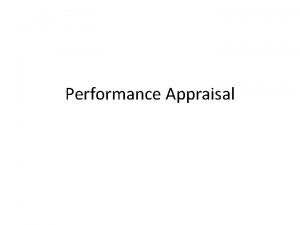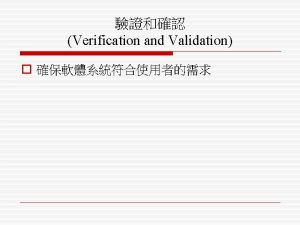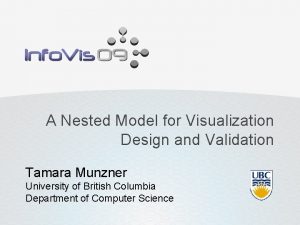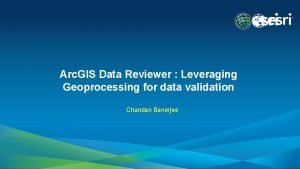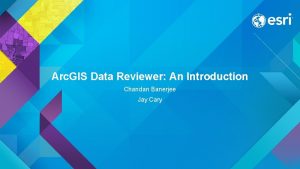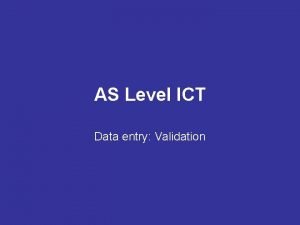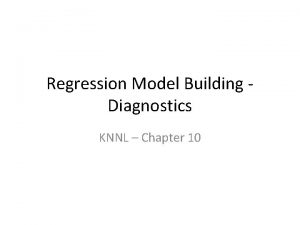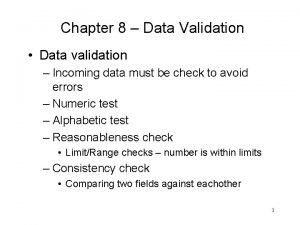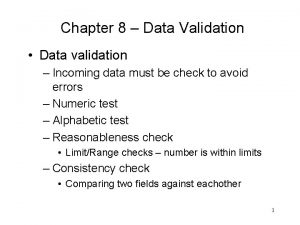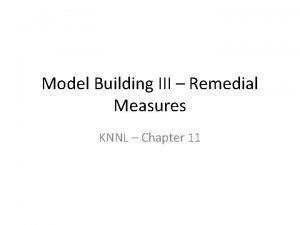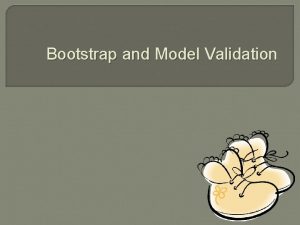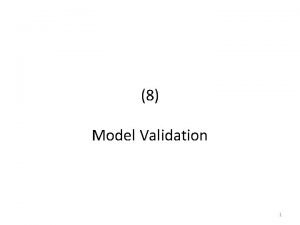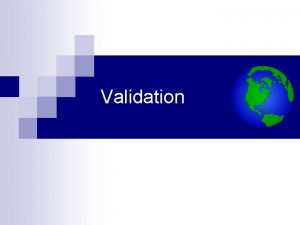Model Selection and Validation KNNL Chapter 9 Data









- Slides: 9

Model Selection and Validation KNNL – Chapter 9

Data Collection Strategies • Controlled Experiments – Subjects (Experimental Units) assigned to X-levels by Experimenter – Purely Controlled Experiments – Researcher only uses predictors that were assigned to units – Controlled Experiments with Covariates – Researcher has information (additional predictors) associated with units • Observational Studies – Subjects (Units) have X-levels associated with them (not assigned by researcher) – Confirmatory Studies – New (primary) predictor(s) believed to be associated with Y, controlling for (control) predictor(s), known to be associated with Y – Exploratory Studies – Set of potential predictors believed that some or all are associated with Y

Reduction of Explanatory Variables • Controlled Experiments – Purely Controlled Experiments – Rarely any need or desire to reduce number of explanatory variables – Controlled Experiments with Covariates – Remove any covariates that do not reduce the error variance • Observational Studies – Confirmatory Studies – Must keep in all control variables to compare with previous research, should keep all primary variables as well – Exploratory Studies – Often have many potential predictors (and polynomials and interactions). Want to fit parsimonious model that explains much of the variation in Y, while keeping model as basic as possible. Caution: do not make decisions based on single variable t-tests, make use of Complete/Reduced models for testing multiple predictors

Model Selection Criteria – All Possible Regressions

Regression Model Building • Setting: Possibly a large set of predictor variables (including interactions). • Goal: Fit a parsimonious model that explains variation in Y with a small set of predictors • Automated Procedures and all possible regressions: – Backward Elimination (Top down approach) – Forward Selection (Bottom up approach) – Stepwise Regression (Combines Forward/Backward)

Backward Elimination Traditional Approach • Select a significance level to stay in the model (e. g. SLS=0. 20, generally. 05 is too low, causing too many variables to be removed) • Fit the full model with all possible predictors • Consider the predictor with lowest t-statistic (highest P-value). – If P > SLS, remove the predictor and fit model without this variable (must re-fit model here because partial regression coefficients change) – If P SLS, stop and keep current model • Continue until all predictors have P-values below SLS • Note: R uses model based criteria: AIC, SBC instead

Forward Selection – Traditional Approach • Choose a significance level to enter the model (e. g. SLE=0. 20, generally. 05 is too low, causing too few variables to be entered) • Fit all simple regression models. • Consider the predictor with the highest t-statistic (lowest P-value) – If P SLE, keep this variable and fit all two variable models that include this predictor – If P > SLE, stop and keep previous model • Continue until no new predictors have P SLE • Note: R uses model based criteria: AIC, SBC instead

Stepwise Regression – Traditional Approach Select SLS and SLE (SLE<SLS) Starts like Forward Selection (Bottom up process) New variables must have P SLE to enter Re-tests all “old variables” that have already been entered, must have P SLS to stay in model • Continues until no new variables can be entered and no old variables need to be removed • Note: R uses model based criteria: AIC, SBC instead • •

Model Validation • When we have a lot of data, we would like to see how well a model fit on one set of data (training sample) compares to one fit on a new set of data (validation sample), and how the training model fits the new data. • Want data sets to be similar wrt levels of the predictors • Training set should have at least 6 -10 times as many observations than potential predictors • Models should give similar model fits based on SSEp, PRESSp, Cp, and MSEp and regression coefficients • Mean Square Prediction Error when training model is applied to validation sample:
